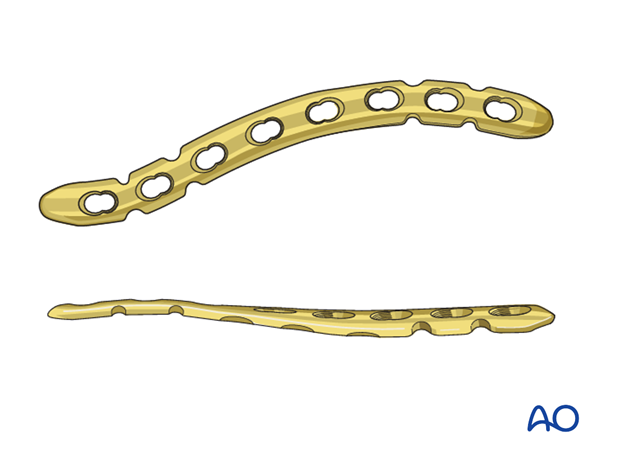ORIF - Bridge plate
1. Introduction
Bridge plating
Bridge plating (or biological plating) is a technique to achieve relative stability by splinting. This allows for indirect healing with preservation of blood supply and soft tissue attachments while bridging the fracture zone maintaining the correct length, rotation and alignment. Anatomical reduction of each fracture fragment is not necessary.

Plate alternatives
A precontoured plate is useful in situations when normal anatomical landmarks are distorted or there is significant bone fragmentation. We will here show the procedure with a precontoured clavicular plate which has both a bend and a twist built into it.

However, if a precontoured clavicular plate is not available, there are other options.
A straight plate may be used if it fits the clavicle (conventional or angle stable). If it does not, then it needs to be contoured.
This is best achieved with a slight twist at the midportion of the plate. This results in the lateral plate being applied superiorly and the medial portion anteriosuperiorly. A reconstruction plate which is easier contour may be used in smaller patients where the forces working on the plate are not as great.

When the fracture location is more lateral or more medial, the bone quality near the metaphysis may not offer sufficient screw purchase. In these instances, a plate offering additional screw fixation may be required (eg, longer plate, periarticular plate, locking head screws).

Plate length
The goal when choosing the plate length is to reduce the concentration of bending forces. This typically requires a longer plate. Care must be taken not to insert a screw in each hole of the plate or rigidly fix fracture gaps.

2. Patient preparation and approach
Patient preparation
This procedure is normally performed with the patient either in a beach chair or a supine position.
Approach
For this procedure an anterior approach is normally used.

3. Reduction and fixation
Reduction
Fracture fragments should not be devitalized or stripped from their soft tissue attachments. Achieve reduction by indirect means where possible.
The aim is to restore normal alignment and rotation as well as length. At times some sacrifice of length may be acceptable in order to improve bone contact and avoid excessive gapping.

Plate application
The plate can often assist as a reduction tool to restore the length and rotation.
A properly contoured plate is usually fixed first to the medial side as medial side malalignment is less well tolerated. The lateral fragment is then reduced by manipulation involving traction and rotation and is aligned anatomically with the lateral side of the plate.

The superior surface of the lateral fragment is flat and readily identified. Reduction of the plate to the superior flat surface of the lateral segment will often restore the correct rotation.

A push-pull device is often helpful in obtaining the appropriate clavicular length when manual distraction is unsuccessful.

Once the fracture alignment, length, and rotation are satisfactory, the remaining screws can be inserted.

4. Aftercare
The aftercare can be divided into 4 phases:
- Inflammatory phase (week 1–3)
- Early repair phase (week 4–6)
- Late repair and early tissue remodeling phase (week 7–12)
- Remodeling and reintegration phase (week 13 onwards)
Full details on each phase can be found here.













